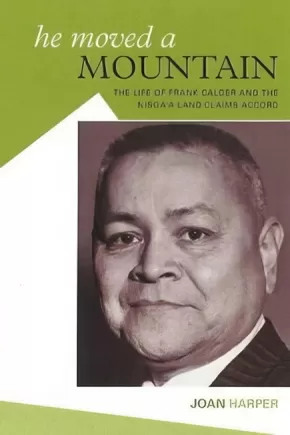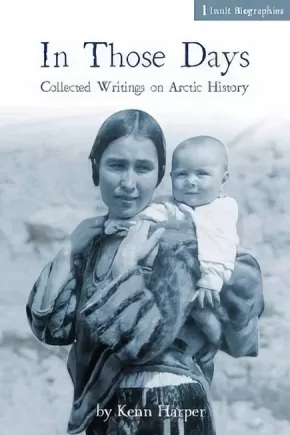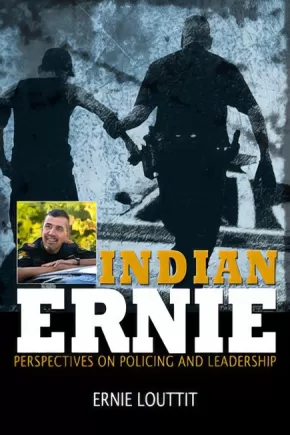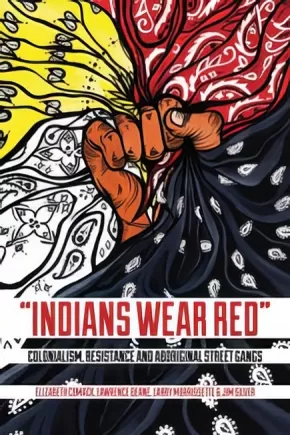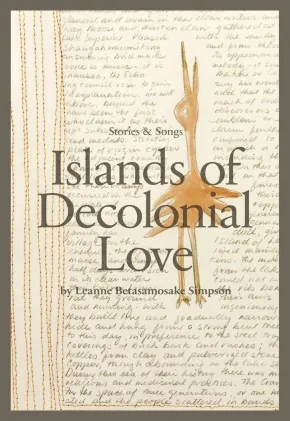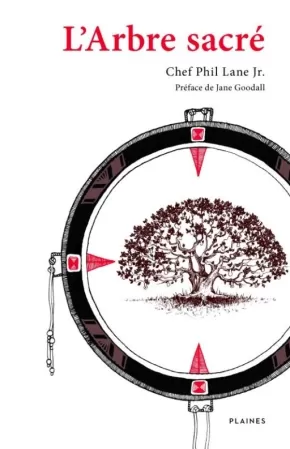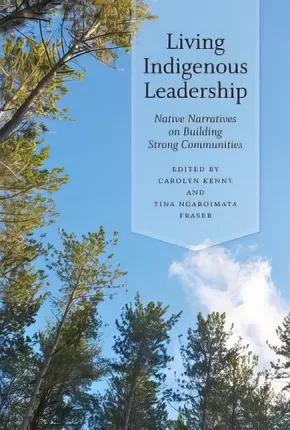Browse Books for Adults
Synopsis:
Dr. Frank Arthur Calder of BC's Nisga'a First Nation was the first aboriginal person to be elected to any Canadian governing body. For twenty-six years he served as an MLA in the legislature of British Columbia. He was the driving force behind Canada's decision to grant recognition of aboriginal land title to First Nations people throughout the country. He accomplished this goal by guiding the controversial request through a series of court cases, finally to the Supreme Court of Canada, achieving success when Parliament, in an all-party resolution, passed a measure recognizing indigenous title. Because of this historic decision, Canada serves as a resource for other aboriginal populations in countries where similar accommodations for aboriginal people have not yet been made. Calder received many honours in his lifetime, including the Order of Canada. The one he most cherished, however, was one rarely bestowed by the Nisga'a Nation: "Chief of Chiefs." While growing up, Frank went to grade 10 in residential school, completed high school and then graduated from the University of BC (in the Anglican Theological College). It took him two years longer than usual to complete university, as he had to return home during the fishing season to earn the money for his tuition.
Synopsis:
Imagine Mercy is a vibrant poetry collection portraying the daily realities of living as an Aboriginal in Canada. David Groulx seamlessly weaves the spiritual with the ordinary and the present with the past. He speaks for the spirit, determination, and courage of Aboriginal people, compelling readers to confront cruel reality with his honest and inspiring vision. The poems in Imagine Mercy portray mixed bloods, resistance, determination, sovereignty, and cultural issues that generate sharply divided opinions and deep emotional struggles. Groulx’s poetic power renders an honest and painful perception of modern-day Aboriginal life with strong voice against prejudice and injustice.
Educator & Series Information
This book is part of the Canadian Aboriginal Voices series.
Additional Information
96 pages | 5.50" x 8.50"
Synopsis:
Arctic historian Kenn Harper gathers the best of his columns about Inuit history, which appear weekly in Nunatsiaq News, in this exciting new series of books.
Each installment of In Those Days: Collected Columns on Arctic History will cover a particularly fascinating aspect of traditional Inuit life. In volume one, “Inuit Biographies,” Harper shares the unique challenges and life histories of several Inuit living in pre-contact times.
The result of extensive interviews, research, and travel across the Arctic, these amazing short life histories provide readers with a detailed understanding of their specific time and place.
Series Information
This book is part of the In Those Days series, a historical series that collects writings on Arctic history.
Additional Information
200 pages | 6.00" x 9.00"
Synopsis:
When he began his career with the Saskatoon Police in 1987, Ernie Louttit was only the city’s third native police officer. Indian Ernie, as he came to be known on the streets, details an era of challenge, prejudice, and also tremendous change in urban policing. Drawing from his childhood, army career, and service as a veteran patrol officer, Louttit shares stories of criminals and victims, the night shift, avoiding politics, but most of all, the realities of the marginalized and disenfranchised.
Louttit spent his entire career (including as a Sergeant) patrolling the streets of Saskatoon’s west side, an area until recently beset by poverty, and terrible social conditions. Here, he struggled to bring justice to communities where the lines between criminal and victim often blurred. Though Louttit’s story is characterized by conflict, danger, and violence, he argues that empathy and love for the community you serve are the greatest tools in any officer’s hands, especially when policing society’s less fortunate.
While his story is based on his experiences in Saskatoon, it is equally applicable to the challenges faced in any community where marginalized people live. It is an exciting, passionate, easy to read, and highly accessible story aimed at a broad audience.
Synopsis:
With the advent of Aboriginal street gangs such as Indian Posse, Manitoba Warriors, and Native Syndicate, Winnipeg garnered a reputation as the “gang capital of Canada.” Yet beyond the stereotypes of outsiders, little is known about these street gangs and the factors and conditions that have produced them. “Indians Wear Red” locates Aboriginal street gangs in the context of the racialized poverty that has become entrenched in the colonized space of Winnipeg’s North End. Drawing upon extensive interviews with Aboriginal street gang members as well as with Aboriginal women and elders, the authors develop an understanding from “inside” the inner city and through the voices of Aboriginal people — especially street gang members themselves.
While economic restructuring and neo-liberal state responses can account for the global proliferation of street gangs, the authors argue that colonialism is a crucial factor in the Canadian context, particularly in western Canadian urban centres. Young Aboriginal people have resisted their social and economic exclusion by acting collectively as “Indians.” But just as colonialism is destructive, so too are street gang activities, including the illegal trade in drugs. Solutions lie not in “quick fixes” or “getting tough on crime” but in decolonization: re-connecting Aboriginal people with their cultures and building communities in which they can safely live and work.
Synopsis:
In her debut collection of short stories, Islands of Decolonial Love, renowned writer and activist Leanne Simpson vividly explores the lives of contemporary Indigenous Peoples and communities, especially those of her own Nishnaabeg nation. Found on reserves, in cities and small towns, in bars and curling rinks, canoes and community centres, doctors offices and pickup trucks, Simpson’s characters confront the often heartbreaking challenge of pairing the desire to live loving and observant lives with a constant struggle to simply survive the historical and ongoing injustices of racism and colonialism. Told with voices that are rarely recorded but need to be heard, and incorporating the language and history of her people, Leanne Simpson’s Islands of Decolonial Love is a profound, important, and beautiful book of fiction.
Additional Information
148 pages | 5.50" x 8.50"
Synopsis:
When the Kitchenuhmaykoosib Inninuwug’s traditional territory was threatened by mining exploration in 2006, they followed their traditional duty to protect the land and asked the mining exploration company, Platinex, to leave. Platinex left — and then sued the remote First Nation for $10 billion. The ensuing legal dispute lasted two years and eventually resulted in the jailing of community leaders. Ariss argues that though this jailing was extraordinarily punitive and is indicative of continuing colonialism within the legal system, some aspects of the case demonstrate the potential of Canadian law to understand, include and reflect Aboriginal perspectives. Connecting scholarship in Aboriginal rights and Canadian law, traditional Aboriginal law, social change and community activism, Keeping the Land explores the twists and turns of this legal dispute in order to gain a deeper understanding of the law’s contributions to and detractions from the process of reconciliation.
Synopsis:
Créé au départ pour épauler les Premières Nations dans leur cheminement, L’Arbre sacré met en évidence les concepts, les principes et les enseignements de la spiritualité autochtone. Plus qu’un guide, cet ouvrage révèle comment les grandes valeurs traditionnelles peuvent jouer un rôle, non seulement au niveau individuel, mais aussi au niveau communautaire et planétaire. L’Arbre sacré est un texte de référence pour tous ceux et celles qui s’intéressent à la sagesse des Premiers Peuples.Le Créateur a planté, pour tous les habitants de la terre, un Arbre sacré sous lequel ils peuvent trouver ensemble l’apaisement, la force, la sagesse et la sécurité. Les racines de cet arbre s’enfoncent profondément dans notre Mère-Terre. Ses branches s’élèvent vers le firmament comme des mains tendues pour une prière au Père-Ciel. Ses fruits représentent les dons du Créateur : des enseignements qui montrent le chemin de l’amour, de la compassion, de la générosité, de la patience, de la sagesse, de la justice, du courage, du respect, de l’humilité et de tant d’autres dons.
Educator Information
This is the French version of The Sacred Tree.
Synopsis:
“Dad, I don’t want to play football or baseball,” I blurted out.
“Oh, what do you want to play?” he asked. “Basketball? I hope its not soccer. That’s not even a real American sport.”
“Stickball,” I said.
“Say what?” Dad replied. He almost spit out a mouth full of coffee.
“Stickball. Toli.”
“You mean running around in your shorts behind the community center on Saturdays? That’s not a real sport.”
“Actually it is a real sport, and I’m talking about playing on a team that will compete at Choctaw Fair next summer.”
Dad slammed his fist down on the table. The plates and glasses shook. I almost jumped out of my seat.
Sixteen-year-old Mississippi Choctaw Randy Cheska lived most of his young life in the shadow of his older football-hero brother, Jack. After Jack is tragically killed while serving in Iraq, Randy's father puts even more pressure on Randy to excel in football. Randy has absolutely no desire or skills to play high school sports but when he discovers that he's good and stickball and loves the game, Randy jumps at the chance to play when its offered. His father considers the sport a relic of the Choctaw past when it was known as the Little Brother of War and used to settle disputes between communities. For Randy, stick ball provides him with a new sense of self-worth and a new direction in life.
Gary Robinson is a writer and filmmaker of Cherokee and Choctaw descent. He has spent 25 years working with American Indian communities to tell the stories of Native people. His previous works include From Warriors to Soldiers and The Language of Victory. He lives in rural central California.
Educator & Series Information
Reading Level: 3.9
This book is part of the PathFinders series of Hi-Lo (high interest, low readability) novels, which offers the following features:
• Indigenous teen protagonists
• Age appropriate plots
• 2.5 – 4.5 Reading Level
• Contemporary and historical fiction
• Indigenous authors
The PathFinders series is from an American publisher. Therefore, Indigenous terminology in the PathFinders books is not the same as Canadian Indigenous terminology. This prompts a useful teaching moment for educators in discussing appropriate terminology use in Canada.
Additional Information
120 pages | 4.53" x 7.00"
Synopsis:
Indigenous scholars strive to produce accessible research grounded in the daily lives of Native peoples, research that will improve their communities in meaningful and sustained ways. They also recognize that long-lasting change depends on effective leadership.
Living Indigenous Leadership showcases innovative research and leadership practices from diverse nations and tribes in Canada, the United States, and New Zealand. The contributors use vibrant stories and personal narratives to offer insights into the unique nature of Indigenous leadership. These dynamic case studies reveal that Native leaders, whether formal or informal, ground their work in embodied concepts such as land, story, ancestors, and elders, concepts rarely mentioned in mainstream studies of leadership. Indigenous leadership, they show, finds its most powerful expression in collaboration, in the teaching and example of Elders, and in community projects to promote higher education, language revitalization, health care, and the preservation of Indigenous arts.
This collection not only adds Indigenous methods to studies on leadership, it also gives a voice to the wives, mothers, and grandmothers who are using their knowledge to mend hearts and minds and to build strong communities. Their personal stories and collective knowledge will inspire further research and future generations.
Synopsis:
maskisina: A Guide to Northern-Style Métis Moccasins is a follow-up to the highly successful wapikwaniy: A Beginner’s Guide to Métis Floral Beadwork. Much like wapikwaniy, maskisina guides readers, step-by-step, on how to create their very own moccasins. It contains detailed photographs along with each step. It also includes a historic overview of moccasins by Sherry Farrell Racette. Patterns for cutting the correct sizes for the soles and vamps are included in the book.
Educator Information
Grade Level: Secondary/Post Secondary/Adult
Synopsis:
The past two decades have witnessed the emerging role of grassroots social movements and community-based peacebuilding as key sites of transformative political and cultural engagement. Merging Fires offers case studies of grassroots alliance building between non-Indigenous activists and three Indigenous communities:
the Chippewa of Nawash,the Grassy Narrows First Nation and the Anishinaabe Grand Council of Treaty #3. These Canadian examples offer insights into the challenges, limitations and complexities of transformative, community-based alliance building and raise critical questions about power, knowledge and pedagogy at the grassroots level.
While this analysis is uniquely Canadian in scope, Merging Fires is of great political relevance in light of the Idle No More movement as well as similar decolonizing initiatives occurring globally. Rick Wallace’s research methodologies and ethics of solidarity are starkly different from many mainstream academic approaches, and his documentation of on-the-ground efforts at peacebuilding fills an important gap in the field.
Additional Information
178 pages | 6.00" x 9.00"
Synopsis:
Contemporary, imaginative interpretations of First Nations cuisine, including lighter, healthier, and more nutritious versions of traditional recipes.
Native American cuisine comes of age in this elegant, contemporary collection that reinterprets and updates traditional Native recipes with modern, healthy twists. Andrew George Jr. was head chef for Aboriginal foods at the 2010 Winter Olympics in Vancouver; his imaginative menus reflect the diverse new culinary landscape while being mindful of an ages-old reverence for the land and sea, reflecting the growing interest in a cuisine that is rapidly moving into the mainstream to become the "next big thing" among food trends. Andrew also works actively at making Native foods healthier and more nutritious; his recipes are lighter, less caloric, and include Asian touches, such as bison ribs with Thai spices, and a sushi roll with various cooked fish wrapped in nori. Other dishes include venison barley soup, wild berry crumble, sea asparagus salad, and buffalo tourtiere.
Full of healthy, delicious, and thoroughly North American fare, Modern Native Feasts is the first Aboriginal foods cookbook to go beyond the traditional and take a step into the twenty-first century.
Reviews
"Modern Native Feasts fuses traditional recipe preparations like brining, smoking, and curing with using fresh, local, seasonal ingredients readily available in many supermarkets. Meals reflect a diverse new culinary landscape built on an age-old reverence for the land and sea." — Gastrotraveling.com, December 2013
"The resulting recipes are unfussy yet often elegant, perfect for either a potlatch or a potluck ... George keeps his intros blessedly short, while still telling the background of each dish; the cookbook is beautifully designed, with a rustic look that's carried throughout." — The Oregonian, November 2013
"Whatever you have in mind when you conjure up the image created by the title Modern Native Feasts, you won't be imagining anything quite like this. Chef George has taken the best of his indigenous Canadian culture and traditions and fused it with his modern training, plus a generous helping of very real talent and created a cuisine that, while it may be distinctly his, could feasibly represent a beautiful -- and delicious -- future ... This is sophisticated contemporary food perfectly informed by the chef's heritage and own sensibilities." ―January Magazine
Additional Information
192 pages | 8.00" x 9.00"
Synopsis:
Aboriginal people who choose to improve their education as adults often face many challenges, most of which arise from the ongoing impact of colonialism and of racialized poverty. Yet in Winnipeg’s low-income inner city, a variety of innovative and effective Aboriginal adult education initiatives have emerged. Drawing upon the voices and experiences of Aboriginal adult learners themselves, this book describes the initiatives and strategies that have proven successful and transformative for adult Aboriginal students.
These programs also positively influence the lives of the students’ families and are even felt on the community level, functioning as anti-poverty initiatives. Moving Forward, Giving Back posits that effective Aboriginal adult education initiatives need to be dramatically expanded to improve the health and vibrancy of Aboriginal people and communities across Canada.
Additional Information
168 pages | 6.00" x 9.00"
Synopsis:
This manual teaches techniques of playing the flute for both the absolute beginner as well as the seasoned player. Using the CD that accompanies this manual, readers will be able to learn the basic skills needed to play.
The author describes the history of the modern Native American Flute and includes the traditional legend of how it became an integral part of the courting ritual. Also included are instructions for maintaining your flute, numerous graphs and illustrations of scales to practice, advice on how to choose the best flute for you, songwriting tips, practice songs, and blank composition sheets. The instructional CD features samples of Jeff Ball's bestselling recordings. Beautiful color photos of both flute players and flutes accompany the text.

